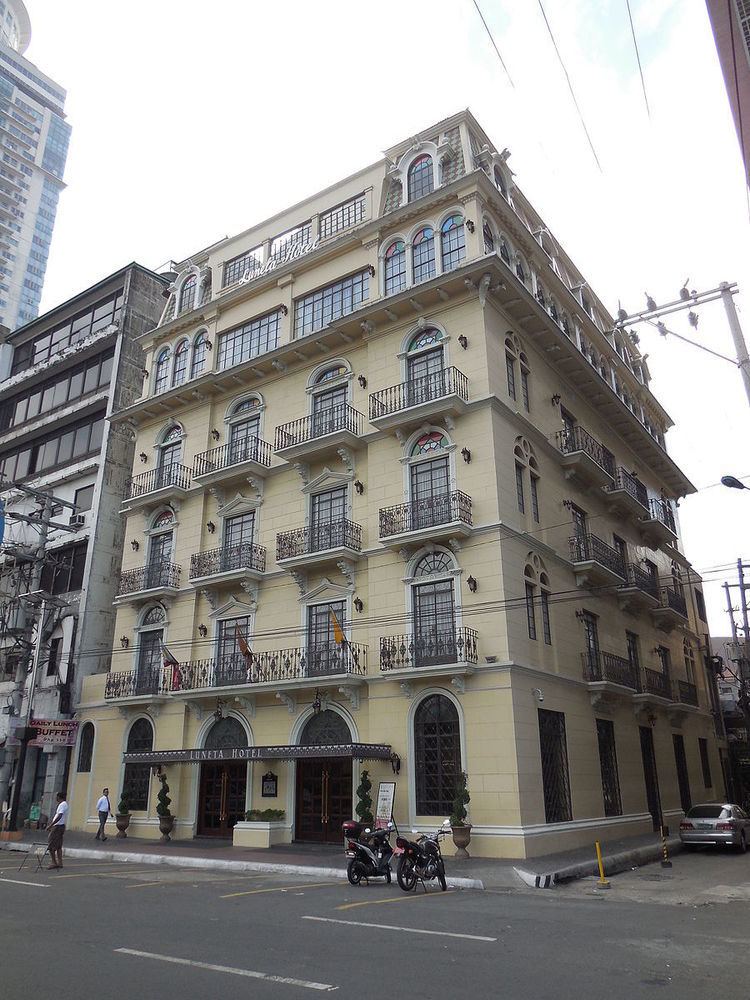Status Complete Completed 1919 Phone +63 2 875 8921 | Closed 1987reopened in 2014 | |
 | ||
Address 414 T.M. Kalaw Avenue, Ermita, Manila, 1045 Metro Manila, Philippines | ||
The Luneta Hotel is a historic hotel in Manila, Philippines. Named after its location across from Luneta (Rizal Park) on Kalaw Avenue in Ermita, it is one of the remaining structures that survived the Liberation of Manila in 1945. The hotel was completed in 1919. According to the study by Dean Joseph Fernandez of the University of Santo Tomas, the hotel was designed by the Spanish architect-engineer Salvador Farre. The structure is the only remaining example of French Renaissance architecture with Filipino stylized beaux arts in the Philippines to date. After being closed down and abandoned in 1987, the hotel was relaunched in May 2014 with the installation of a historical marker by the National Historical Commission of the Philippines.
Contents
Ntg luneta hotel muling nabuhay na atraksyon sa maynila
History
During World War II, the Luneta Hotel became a brothel of American G.I.s who were off to Corregidor after Manila had been declared an open city. Surviving veterans of the war still recall how the hotel served as a hope when it survived the bombardment and how it was turned into a comfort area for soldiers facing eminent death.
In its early years, the hotel became the site of European imports that were distributed to Manila. It was a time of beauty, innovation and peace. The hotel has been known to serve well-prepared breakfast and lunch, exotic among foreigners of the time. But the operations of the Luneta Hotel demanded high-maintenance and so it was neglected even by its owners.
Architecture
Designed by Spanish architect Salvador Farre, the Luneta Hotel on Kalaw Avenue was built in 1919. The six-storey building towered at an undefined T.M. Kalaw street upon its completion. It faced an unfenced Bermuda plane of the Luneta. Its neighbors were blocks of "stone houses" (bahay na bato) and "storerooms" (bodegas). It stood out because of its distinct architectural style. It symbolized the new influence that the Americans brought to the country. As once described by cultural writer and conservationist Bambi Harper, its "Mansard roof, French windows, carved details, attractive grilles and studied proportions" are reminiscent of French Renaissance architecture.
President Dwight Eisenhower wrote about the Luneta Hotel's beauty:
"This Luneta was for more than 4 years the scene of my habitual evening walks. To this day it lives in memory as one of the most pleasant, indeed even one of the most romantic spots, I have known in this entire world. Leaving the front entrance of the Luneta Hotel in the evening, I could walk to the right to view the busy docks where Philippine commerce with the world was loaded and unloaded. From the hotel, looking across the peaceful waters of Manila Bay, I could see the gorgeous sunsets over Miravales. Walking toward the Club of the Army and the Navy, and looking down toward the city itself, I nearly always paused for a moment before the statue of the great José Rizal before returning to my quarters."
